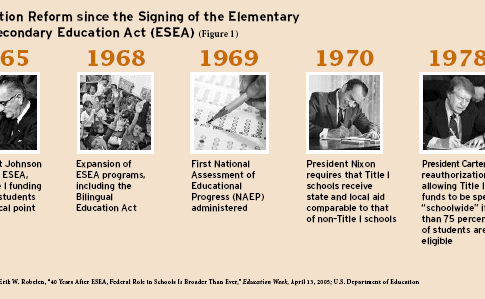 It’s popular in Washington to declare No Child Left Behind (NCLB) an excellent statute (even “99.9% pure,” as Secretary Margaret Spellings once claimed), but complain about its “implementation.” Many individuals on Capitol Hill and in advocacy groups appear sincerely to believe that with the right people calling the shots in the U.S. Department of Education, making good decisions, and acting wisely, the law could work as intended.
It’s popular in Washington to declare No Child Left Behind (NCLB) an excellent statute (even “99.9% pure,” as Secretary Margaret Spellings once claimed), but complain about its “implementation.” Many individuals on Capitol Hill and in advocacy groups appear sincerely to believe that with the right people calling the shots in the U.S. Department of Education, making good decisions, and acting wisely, the law could work as intended.
Is this true? Is implementation the problem? Or are NCLB’s shortcomings much deeper? From my admittedly biased perspective as a former Bush administration official in the Department of Education (DOE), I examine that question through a case study of one of the law’s many ambitious promises: that students in schools in need of “improvement” or “corrective action” can transfer to a better school or receive free tutoring from a private provider at the district’s expense.
These provisions test the limits of well-intended implementation. Unlike other parts of NCLB that were foisted upon the administration by congressional Democrats (such as the law’s “highly qualified teachers” mandate), these policies enjoyed strong support from senior DOE officials, including Secretary of Education Rod Paige. They aligned with core Republican principles of choice and competition. Yet by all accounts, the provisions have disappointed. In 2005, fewer than 1 percent of eligible students participated in NCLB school choice and just under 20 percent took advantage of the free tutoring (see Figure 1). Did the administration botch the implementation of even these favored programs? Or is something else to blame? And what are the implications for NCLB writ large?
Parent Information, School District Resistance
 It almost goes without saying: in order for parents to take advantage of school choice programs, they must know that they exist. Yet experience has shown that in the early days of any choice program, parents lack the information they need to weigh their options. That helps to explain why each of the nation’s school-voucher programs got off to such a slow start. In the federally funded Opportunity Scholarship Program in Washington, D.C., for example, almost half of the available vouchers went unused in the first year of the program because its organizers didn’t have adequate time to inform parents. Other voucher and charter school programs nationwide have shown similar dynamics.
It almost goes without saying: in order for parents to take advantage of school choice programs, they must know that they exist. Yet experience has shown that in the early days of any choice program, parents lack the information they need to weigh their options. That helps to explain why each of the nation’s school-voucher programs got off to such a slow start. In the federally funded Opportunity Scholarship Program in Washington, D.C., for example, almost half of the available vouchers went unused in the first year of the program because its organizers didn’t have adequate time to inform parents. Other voucher and charter school programs nationwide have shown similar dynamics.
So under the best conditions, informing parents of their options under NCLB would be a difficult challenge. But the construction of the law presents a unique problem: it requires local school districts to inform parents of their options, yet doing so is at odds with districts’ own interests. After all, few big-city districts have better schools to offer parents anyway, and few are eager for parents to spend the districts’ dollars on tutors outside the school system’s domain. Plus, if districts don’t spend the required amount on choice or tutoring (a sum equal to 20 percent of their federal Title I allocation), they can use these dollars for their own initiatives. In other words, it’s not “use it or lose it,” it’s “use it for choice and tutoring or use it as you see fit.”
The disincentives to districts to inform parents of their options were easy to see as soon as the law’s ink was dry, and help to explain why so few students are participating in NCLB school choice and tutoring. Let’s examine what DOE tried to do to address these challenges, and consider why its efforts largely failed.
Strategy #1: Appeal to districts to do the right thing
The statute is relatively clear, though not elaborate, about districts’ responsibilities when it comes to communicating with parents. They must provide information “in an understandable and uniform format and, to the extent practicable, in a language that parents can understand.” The districts must explain why the child’s school is “in need of improvement” in the first place, including “how the school compares in terms of academic achievement to other elementary schools or secondary schools served by the local educational agency and the State educational agency.” They must make clear “the parents’ option to transfer their child to another public school” or “to obtain supplemental educational services [free tutoring] for the child.” These notices must come “not later than the first day of the school year” following the identification of a school “in need of improvement.” Districts obligated to provide supplemental educational services must annually give parents a “brief description of the services, qualifications, and demonstrated effectiveness” of each approved tutoring provider in the district.
In the first version of its “Public School Choice: Non-Regulatory Guidance,” published in December 2002, the department built on these basic statutory requirements to encourage districts to provide helpful information to parents: “The [local educational agency] should work together with parents to ensure that parents have ample information, time, and opportunity to take advantage of the opportunity to choose a different public school for their children.” That same month, in its “Supplemental Educational Services: Non-Regulatory Guidance,” the department encouraged districts to “consider multiple avenues for providing general information about supplemental educational services, including newspapers, Internet, or notices mailed or sent to the home.”
DOE took another bite at the apple in August 2003, when it published an updated version of its supplemental educational services guidelines. Frustrated that the letters some districts were sending home actually discouraged parents from taking advantage of free tutoring, the department added new language. “Any additional information in a notice should be balanced and should not attempt to dissuade parents from exercising their option to obtain supplemental educational services for their child.” This mild rebuke, in the form of non-binding “guidance,” was hardly going to spur districts to change course.
Still trying to appeal to districts’ better angels, in May 2004 the department published Innovations in Education: Creating Strong District School Choice Programs. This colorful booklet culled “best practices” from five school districts with vast experience implementing their own public school-choice programs. Under headings like “Communicate Clearly About NCLB Choice Options” and “Provide Personalized Follow-Up,” the publication gave concrete, actionable advice to districts that wanted to implement the choice provisions effectively. Importantly, it also provided sample letters (from Milwaukee) that demonstrated how districts could communicate to parents in a straightforward, jargon-free way. DOE printed 50,000 copies of these booklets, distributed them widely, and posted a version online. It also used the booklet at a variety of forums and conferences.
But from the department’s perspective in Washington, boosting districts’ know-how didn’t seem to make much of a difference; those pesky perverse incentives hadn’t gone away. So the department devised a new strategy: if you can’t work through the districts, work around them.
Strategy #2: Empower the outsiders
While school districts didn’t see much benefit in touting NCLB’s choice opportunities, several advocacy groups did. Organizations such as the Black Alliance for Educational Options (BAEO), the Hispanic Council for Reform and Educational Options (HCREO), and the Greater Educational Opportunities Foundation (GEO) viewed parental outreach as central to their mission. One of BAEO’s objectives, for example, is to “educate Black families about the numerous educational options available.”
So administration officials responded enthusiastically when these organizations applied for grants under the department’s Fund for the Improvement of Education (FIE), also known as the “Secretary’s discretionary fund.” The department doled out $1.5 million to BAEO, $900,000 to HCREO, and $750,000 to GEO. Each of these groups set out to inform parents of their NCLB options in target cities. BAEO’s “Project Clarion” launched aggressive outreach campaigns in cities such as Detroit, Atlanta, and Philadelphia. Using a mix of radio ads, grass-roots communication, and media relations, the organization sought to inform parents of their NCLB school choice and free tutoring options. The project had some success; awareness of NCLB and its choices increased in BAEO’s target cities from 37 percent to 72 percent over the three years of the initiative.
Unfortunately discretionary FIE funds were quite limited, and these targeted campaigns couldn’t come close to having a national impact. But the department’s Parent Information and Resource Centers program (PIRC) had a substantial amount of money (almost $40 million in 2006). Despite its name, PIRC wasn’t designed to inform parents about school choice options. A holdover from President Clinton’s Goals 2000 law, the centers’ primary role was to fund parent education programs, with a focus on early childhood. Regardless, department officials used the grant application process to establish priorities (i.e., bonus points) for PIRCs willing to do the work of informing parents of their options under NCLB. Soon the nation’s 70-odd PIRCs were engaging in parental information campaigns of one sort or another.
It’s hard to know for sure whether any of these outside-the-system efforts worked. To this day there are no good, comparable, city-by-city data on participation rates in NCLB school choice or supplemental educational services, so it’s impossible to know if participation spiked in communities where the PIRCs and other groups targeted their efforts. With millions of children nationwide eligible for choice and free tutoring, even these activities have to be seen as mostly symbolic.
Strategy #3: Offer carrots
DOE soon came to believe that what mattered most was whether districts themselves “bought into” the choice and tutoring provisions and launched aggressive outreach campaigns. Districts have some particular advantages: They have access to student information nobody else has: they know exactly who is eligible for choice and tutoring. They have the power to send information home in students’ backpacks and, even more importantly, to instruct school principals, counselors, and teachers to give parents information about these options at school-sponsored events such as back-to-school night and during parent/teacher conferences. As the Innovations in Education booklets made clear, parents are most likely to trust and act on information coming from their child’s teacher and principal.
So with the arrival of Secretary Spellings in the second term of the Bush administration, DOE tried a new tactic: replace the law’s perverse incentives (which pushed districts to avoid aggressive parental outreach) with carrots, offers that would encourage them to play ball. The department launched two different pilot programs. First, in August 2005, it allowed four districts in Virginia (and later another 12 districts in four additional states) to flip-flop the order of NCLB school choice and free tutoring. Now districts with schools identified as “in need of improvement” would have to offer supplemental educational services immediately, and could delay NCLB school choice until the next year. In return, those districts had to engage in aggressive parental outreach, demonstrated by significantly improved participation rates in the NCLB school choice and tutoring programs.
The department launched a second pilot with the free tutoring provision. In 2002, Secretary Paige had issued a regulation that disallowed districts “in need of improvement” from providing tutoring directly; to say this rankled the big-city districts is a vast understatement. In 2005 and 2006, the department gave several urban school districts (Anchorage, Boston, Chicago, Hillsborough County [Florida], and Memphis) permission to serve as tutoring providers, even though they were themselves “in need of improvement” under the law. Once again, the deal was that these districts had to show significant progress with parental outreach, as measured by student participation. Specifically, they were required to “notify parents of the availability of SES [supplemental educational services] in correspondence that is simply written and in a language that parents can understand…notify parents of the availability of SES by letter to the student’s home and by at least two other means…[and] broadly circulate information in the community about SES.”
These pilots certainly made political sense. Secretary Spellings was under heavy pressure from the education establishment to show greater “flexibility” with the implementation of the law (see “Texas Hold ’em,” features, Summer 2007). Even members of Congress had come to agree that NCLB school choice should kick in after supplemental educational services. And Spellings felt she had to allow at least some big-city districts to serve as tutoring providers, in part to placate the Council of the Great City Schools, which had been a vocal and courageous advocate for the law. So if she was going to make these policy changes anyway, why not get something in return?
Whether she got a good deal remains to be seen. Results from a third-party evaluation of these pilots have not yet been published. Allowing districts to serve as tutoring providers has had all kinds of deleterious effects on the supplemental educational services program. For example, a Wall Street Journal editorial reported that Chicago, Boston, and Hillsborough County are all using “administrative hurdles to make it very difficult for private and faith-based tutoring programs to reach students.” Of course, no matter what the impact might be in a handful of cities, these pilots will have no effect on the larger national picture.
The Dog That Didn’t Bark: Wielding the Stick
The Department of Education still has not tried getting tough with states and districts deficient on parental outreach. This isn’t the case for the law as a whole; the administration has shown remarkable courage in withholding administrative funds from states for various infractions, such as not testing new elementary school teachers before they enter the classroom (as required under the law’s “highly qualified teachers” provision) or failing to include English language learners or special education students in the state’s assessment system.
So why did the department not take similar actions when it came to choice and tutoring? Simply, it’s a matter of gray. The examples cited above are black-and-white: either states tested their new teachers, or they didn’t. The law is clear about what is required; enforcing the statute is fairly straightforward. This is not the case for parent outreach and information; most districts were, in fact, living up to the letter of the law. They sent parents bulletins about their choices and posted information online. Sure, many letters were full of jargon, written to dissuade parents from taking advantage of their options, and a wholly inadequate mechanism for breaking through information overload anyway. But “going through the motions” is not illegal. Simply said, the department did not have grounds to initiate enforcement actions.
Of Hubris and Humility
Let’s return to the original question: Could NCLB work as intended with the right people calling the shots in Washington, making good decisions and acting wisely? When it comes to the law’s failings, is “implementation” really to blame?
At least when it comes to the law’s school choice and tutoring provisions, the answer is clearly no. The Department of Education, especially under Secretary Paige, was firmly committed to the success of these provisions. It tried multiple strategies to make them work effectively, with little success. It’s hard to imagine what else any administration could do to make the provisions work, at least within the confines of the statute.
But that doesn’t mean that changing the law is necessarily the solution, either. There may be no solution to some of these problems because they are inherent in our federalist system. Federal policymakers should consider this a key lesson: While it’s hard to force recalcitrant states and districts to do things they don’t want to do, it’s impossible to force them to do those things well. Washington can coerce states and districts to follow the letter of the law, but not the spirit. And when it comes to complicated school reforms like empowering parents to choose a new school for their child, “going through the motions” isn’t good enough.
When Congress reauthorizes NCLB, it will need greater humility. Rather than trying to mandate transformative change, Uncle Sam should simply provide political cover to reform-minded local leaders. When it comes to NCLB choice and free tutoring, for example, the federal government could offer extra money for districts that volunteer to implement these reforms. Only districts committed to their success would receive the funds. And DOE would get out of the business of trying to force recalcitrant districts to play along.
This is precisely the strategy embedded in the Teacher Incentive Fund, a $100 million effort that funds local pay-for-performance initiatives. Several big-city districts agreed to experiment with this controversial and promising reform, thanks to the availability of “free” money from the federal government. That sort of demonstration program could work well in other policy domains, too.
A voluntary school-choice grant program is not as bold and exciting as NCLB’s promise that every child trapped in a failing school will have an exit. But this approach is more in line with the capabilities and political realities of the federal government. Meanwhile, most reforms, including those intended to expand school choice, are going to have to develop the old-fashioned way—from the bottom up. That can be slow and frustrating, but it’s the American way.
Michael J. Petrilli served in the U.S. Department of Education from 2001 to 2005 under President George W. Bush. He is now vice president for national programs and policy at the Thomas B. Fordham Foundation, research fellow at the Hoover Institution, and an executive editor of Education Next.





